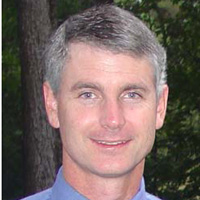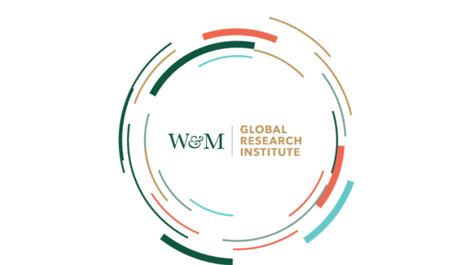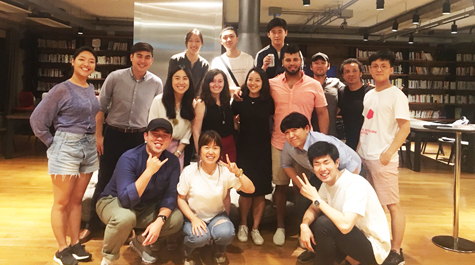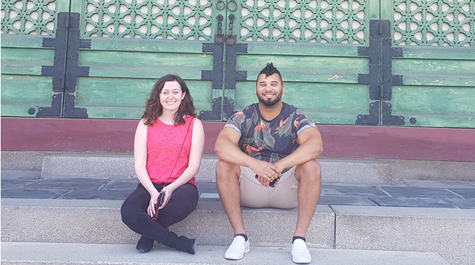Blockchain innovation, from Williamsburg to South Korea
Sometimes the teacher becomes the student.
That’s just what happened when Troy Wiipongwii MPP ’18 and Professor Mike Tierney ’87 began collaborating on a project on blockchain technology.
What is it? The 'blocks' in blockchain are transactions, such as a purchase, made via the internet. The blocks are linked together with other 'blocks' in a chain using a specific code that includes the identifying code for both the block being added, and the block before it. This makes blockchain a sort of digital ledger and difficult to change, but clearly shows the order in which transactions happened.
In addition, blockchain is publicly accessible technology, and is used for keeping records of cryptocurrency transactions, such as Bitcoin.
The role reversal between Tierney and Wiipongwii has been enormously productive. Their project has catalyzed partnerships with W&M alumni in East Asia and launched several new business ventures.
Wiipongwii, a graduate of W&M’s Master of Public Policy Program, remembers his first meeting with Tierney, a professor in the Department of Government and co-director of W&M’s Global Research Institute.
“As soon as I walked into his course on the political environment of policy making, I was talking about tech policy and blockchain as solutions to policy problems. He had no idea what I was talking about,” he said, laughing.
Wiipongwii, who had previously run his own tech startup company, ended up writing a memo for Tierney’s class on how the technology could be used to make foreign aid programs more efficient and effective.
The potential of blockchain stuck with Tierney.
“My own research focuses on bargaining under hierarchy – how do elected leaders get their various agents to implement policy in an accountable way?” Tierney said. “Information problems abound. It turns out, blockchain technology has the potential to solve lots of different information problems that plague policy-makers.”
More than a year later, when Tierney was presenting research on the Institute’s AidData Project during a trip to East Asia, he met a W&M alum, Danny Levinson ’96, who worked in the blockchain industry. Levinson asked if some bright W&M students could help him to think through a problem he was facing at work — could we get a more systematic assessment of how different governments in East Asia were regulating this new technology, as well as forecast what they might do in the future?
It was music to Tierney’s ears. W&M excels at solving such public policy questions. He immediately thought of Wiipongwii.
“He shot me an email that very night,” Wiipongwii recalled. “Writing, ‘You’re the one who is always talking about this. What do you say we collaborate on this and turn this into a small class next semester?’”
They reached out to other students at W&M — some with Chinese language skills, some from the business school and others who had the technical know-how to understand how the new technology might make a difference. With input and financial support from Levinson, Wiipongwii and Tierney developed a course that introduced students to blockchain technology and analyzed changing regulatory regimes in six East Asian countries.
Among other assignments, the students worked on a white paper that they presented at the end of the semester, which is now having a real-world impact on Levinson’s work.
The team had “a disciplined yet creative research approach,” Levinson explained, functioning as a “well-managed consulting team that could prepare and deliver good market intelligence.”
Tierney further reflected that “ideas incubated in William & Mary classrooms, when combined with some serious sweat equity and good partners, can lead to new projects, methods and tools that have an impact in the world beyond the university.”
Following the success of the class, W&M’s Global Research Institute, in partnership with the W&M Freeman Fellows program, helped to place Wiipongwii with Kelsey Robarts MPP '18 at the Art Center Nabi in South Korea. There, Wiipongwii and Robarts worked with the art center’s director, Soh Yeong Roh ’84, helping advise blockchain startups and design a blockchain-based reforestry project that is now under review for funding at the South Korean Ministry for the Environment.
Asked about Wiipongwii and Robarts, Soh Yeong replied, “Their knowledge about blockchain and also their passion about social impact projects were a definite plus to our blockchain community here in Korea."
Wiipongwii and a business partner are now working on several projects for environmental and social impact.
“Even though I’ve been in the blockchain space for years, being at W&M, working with people like Mike, and having the opportunity to go to South Korea through the Institute has given me confidence and opened up professional opportunities,” he said. “It has completely changed my trajectory, and in the next couple of months I’m confident that my partner and I will be running a multimillion-dollar company.”
Meanwhile, back at W&M, Tierney continues to explore blockchain, particularly its potential applications in the international development space. Inspired by the class he created with Wiipongwii last spring, he is experimenting with a blended model of online teaching, led by practitioners in the policy world, combined with Williamsburg-based research projects. This class — a first of its kind on campus — kicks off next year.
Wiipongwii and Tierney’s collaboration illustrates what W&M’s Global Research Institute hopes to achieve, supporting teams of students and faculty who are creating new knowledge and providing transformational experiences to help support the next generation of leaders.
“I’m thrilled that Troy has been able to combine his education in public policy with computer science and business,” Tierney said. “Turns out, if you have the right collaborative culture within an organization and you build a community where students feel empowered, great things happen.”
Follow more of Wiipongwii’s journey. Keep up with Tierney’s latest research and work. Learn more about W&M’s Global Research Institute.
Author David Trichler is director of operations for W&M's Global Research Institute.
















